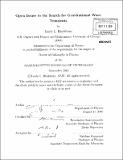Open Issues in the search for gravitational wave transients
Author(s)
Blackburn, Lindy L
DownloadFull printable version (22.44Mb)
Other Contributors
Massachusetts Institute of Technology. Dept. of Physics.
Advisor
Erotokritos Katsavounidis.
Terms of use
Metadata
Show full item recordAbstract
The LIGO-Virgo network of kilometer-scale laser interferometric gravitational-wave detectors reached a major milestone with the successful operation of LIGO's fifth (S5) and Virgo's first (VSR1) science runs during 2005-2007. This thesis presents several issues related to gravitational-wave transient detection from the perspective of the joint all-sky, un-triggered burst search over S5/VSR1 data. Existing searches for gravitational-wave bursts must deal with the presence of non-Gaussian noise transients which populate the data over the majority of sensitive signal space. These events may be confused with true signals, and are the current limiting factor in search sensitivity and detection confidence for any real event. The first part of this thesis focuses on the development of tools to identify, monitor and characterize these instrumental disturbances in LIGO and Virgo data. An automated procedure is developed and applied to the S5/VSR1 search in order to safely remove noise transients from the analysis without sacrificing sensitivity by making use of the wealth of auxiliary information recorded by the detectors. The second part of this thesis focuses on the interpretation of outlier events in the context of a non-Gaussian, non-stationary background. An extensive follow-up procedure for candidate gravitational-wave events is developed and applied to a single burst outlier from the S5/VSR1 search, later revealed to be a blind simulation injected into the instruments. While the follow-up procedure correctly finds no reason to reject the candidate as a possible gravitational wave, it highlights the difficulty in making a confident detection for signals with similar waveform morphology to common instrumental disturbances. The follow-up also deals with the problem of objectively defining the significance of a single outlier event in the context of many semi-disjoint individual searches. To address this, a likelihood-ratio based unified ranking is developed and tested against the original procedures of the S5/VSR1 burst search. The new ranking shows a factor of four improvement in the statistical significance of the outlier event, and a 12% reduction using fixed thresholds and 38% reduction using a loudest event statistic for a rate upper limit on a mock signal population.
Description
Thesis (Ph. D.)--Massachusetts Institute of Technology, Dept. of Physics, 2010. Cataloged from PDF version of thesis. Includes bibliographical references (p. 193-201).
Date issued
2010Department
Massachusetts Institute of Technology. Department of PhysicsPublisher
Massachusetts Institute of Technology
Keywords
Physics.